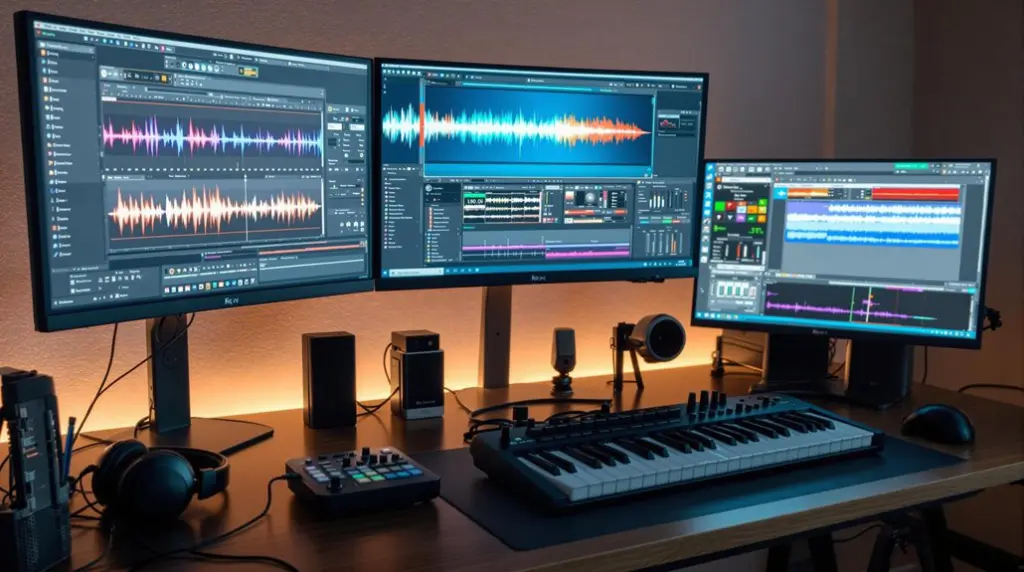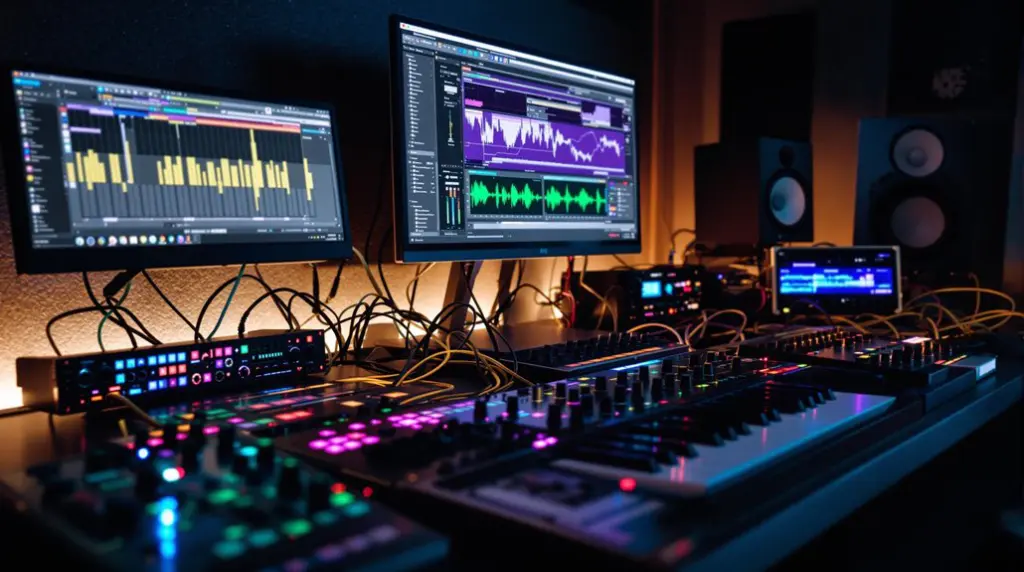The Yamaha Reface DX synthesizer stands out for its compact design, making it ideal for mobile musicians, complemented by intuitive controls and MIDI connectivity. Its 8-note polyphony and four-operator FM engine provide rich, complex sound quality, with real-time manipulation for dynamic performance. Originally inspired by the DX7, the Reface DX balances vintage charm and modern features, priced at $799. It offers a value-packed option with built-in effects and extensive user presets, fostering creativity for both novices and professionals. Explore how its portability, versatility, and nostalgic tones can enhance your music creation experience.
Key Takeaways
- Compact and portable design with intuitive controls suitable for all skill levels.
- Excellent sound quality with 8-note polyphony and advanced FM synthesis engines.
- Real-time operator manipulation and built-in effects enhance live performance versatility.
- Affordably priced at $799, offering great value for professional sound and features.
- Ideal for musicians seeking a blend of classic Yamaha tones with modern digital technology.
Format and Interface
The Yamaha Reface DX stands out with its compact design, which greatly enhances portability and usability, making it an ideal choice for mobile musicians. This synthesizer is meticulously crafted, reflecting a balanced fusion of design aesthetics and functional utility.
Its solid build quality instills confidence, although minor issues have been noted with the sliders, which occasionally detract from an otherwise robust construction. The interface is reminiscent of Apple Logic Pro, offering a blend of intuitive controls and advanced features that cater to both beginners and professionals.
The incorporation of mini keys is a strategic choice, facilitating quick and flawless playability. This design element caters to both beginners and seasoned players, ensuring an inclusive user experience. Furthermore, the touch controls are highly responsive, allowing for versatile parameter adjustments. The ability to modify multiple parameters simultaneously is particularly praised, enhancing creative flexibility during live performances or studio sessions.
Despite initial confusion in guiding through the editing interface, users typically find that familiarity with the system alleviates these concerns. This learning curve ultimately results in a balanced user experience that marries nostalgia with innovation, a reflection of Yamaha’s design philosophy.
To conclude, the Reface DX’s format and interface are thoughtfully designed to meet the needs of modern musicians, blending portability with advanced control capabilities.
Sound Quality
Exhibiting remarkable sonic precision, Yamaha Reface DX delivers an immersive auditory experience through its 8-note polyphony and sophisticated four-operator FM engine. This configuration guarantees sound clarity that greatly surpasses its predecessor, the DX100. The built-in speakers, while limited in bass response, offer surprisingly good sound for their size, although resonance issues may occur due to the lack of lower frequencies.
The sound clarity and audio depth of the Reface DX are further enhanced by its velocity response and real-time parameter adjustments, which provide a high degree of expressiveness and playability. The synthesizer features a variety of built-in effects that contribute to overall sound enhancement, making it a versatile tool for musicians seeking to sculpt unique sound textures.
| Feature | Description | Impact on Sound Quality |
|---|---|---|
| Polyphony | 8-note | Enhanced complexity and richness in sounds |
| FM Engine | Four-operator | Pristine FM sound quality |
| Built-in Effects | Various (reverb, delay, etc.) | Versatility in sound sculpting |
Factory presets and user-generated sounds from Yamaha’s Soundmondo site further showcase the wide sonic range of the Reface DX, appealing to musicians in search of both classic and novel auditory experiences. These features collectively underscore the instrument’s capability to deliver an immersive and high-fidelity auditory experience.
Sound Design Features
Beyond its commendable sound quality, Yamaha Reface DX’s sound design features present a sophisticated toolkit for sonic experimentation. Central to this is its six-operator sound engine, which, despite some perceptions of limited depth, offers substantial flexibility for sound sculpting. The velocity response feature greatly enhances expressiveness, allowing for nuanced performances that are more dynamic and responsive compared to previous models.
Additionally, users can further enhance their tracks by experimenting with textures like smooth, gritty, metallic, and atmospheric elements, adding depth to their sound design.
One of the standout elements is the ability to access and manipulate multiple operators simultaneously. This real-time operator manipulation provides a dynamic platform for live sound editing, facilitating intricate adjustments during performances.
Additionally, the introduction of waveshaping techniques in place of traditional feedback mechanisms represents a significant advancement. Waveshaping opens new vistas for sound exploration, enabling users to craft unique tonal textures that were previously unattainable.
Despite the 8-note polyphony limit presenting certain challenges within FM synthesis, the Reface DX remains versatile. It integrates seamlessly with existing sound patches, making it a practical tool for both studio and live settings.
Historical Context
Positioning the Yamaha Reface DX within its historical context requires an understanding of its lineage and technological advancements. The Yamaha DX7, introduced in 1983, was a seminal instrument in electronic music, incorporating velocity and touch sensitivity, thereby expanding the expressive capabilities of synthesizers. This innovation laid the groundwork for the DX legacy impact, making FM synthesis a pivotal part of modern sound design.
The Reface DX, introduced in 2015, marks the first new DX synthesizer since the DX200 module in 2001. This 14-year gap underscores Yamaha’s strategic return to FM synthesis evolution, reflecting both technological advancements and market demand. One of the key challenges of earlier DX models was their complex programming interface, which often discouraged broader adoption despite their sonic capabilities.
The Reface DX addresses this by offering a more intuitive, user-friendly interface, effectively democratizing FM synthesis for a new generation of musicians. This shift towards accessibility mirrors the broader trends in electronic music, where technological innovations have historically expanded creative possibilities.
Furthermore, the Reface DX is positioned as a cost-effective option at $799, making it accessible compared to larger, more expensive FM synthesis units. By reviving classic sounds with modern usability, the Reface DX continues the DX legacy impact, bridging the gap between vintage appeal and contemporary functionality.
Recommendations
Understanding the historical significance and technological advancements of the Yamaha Reface DX sets the stage for discussing informed recommendations for potential users. This synthesizer is an excellent choice for musicians delving into FM synthesis, thanks to its portability advantages and compact design, which allow for effortless transportation and on-the-go creativity.
For beginners, the Reface DX presents a user-friendly interface that demystifies the complex nature of FM synthesis. This intuitive setup facilitates the sound programming process, making it accessible for novice users while still offering depth for more experienced musicians. The impressive sound quality, coupled with built-in effects, enables users to craft unique sound textures that are highly relevant in contemporary music production. Additionally, mastering techniques like dynamic range control can be applied to enhance the output of this synthesizer.
Priced at approximately $799, the Yamaha Reface DX offers a cost-effective alternative to larger FM synthesis units, without compromising on sound quality. This makes it an attractive option for budget-conscious musicians who seek professional-grade sound capabilities.
Additionally, users are encouraged to explore retro sounds, as the Reface DX effectively revives classic Yamaha tones, integrating them with modern features to suit today’s music landscape. This blend of historical charm and modern utility enhances the overall user experience, making it a valuable tool for any music creator.
Frequently Asked Questions
How Long Does Yamaha Reface Last on Batteries?
The Yamaha Reface DX offers reliable battery performance, typically lasting 5-6 hours on 6 AA batteries. Its portable usage is enhanced by a power-saving mode, while a 12V DC power supply guarantees uninterrupted operation for extended sessions.
How Many Voices Are There in the Yamaha Reface Dx?
The Yamaha Reface DX features an 8-voice polyphony, enabling advanced synthesis techniques and intricate sound design. Each voice can be modulated individually, allowing for an expansive range of creative possibilities within its compact, portable framework.
Does Yamaha Reface Have Aftertouch?
The Yamaha Reface DX does not incorporate aftertouch sensitivity or aftertouch functionality. While its mini keys offer velocity sensitivity, the lack of pressure detection post-initial key press may constrain expressive performance for some musicians.
Does Yamaha Reface Have MIDI Out?
The Yamaha Reface DX does not possess a traditional MIDI out connection. However, its MIDI functionality is facilitated through USB, offering extensive connectivity options with modern DAW setups and external controllers for enhanced parameter adjustments and performance capabilities.
Conclusion
The Yamaha Reface DX synthesizer excels in offering a compact and user-friendly interface, superior sound quality, and robust sound design features, all while paying homage to its historical legacy in digital synthesis. The instrument’s capabilities make it a valuable tool for both novice and experienced musicians. Overall, the Yamaha Reface DX stands as a versatile and efficient option for those seeking a high-quality, portable synthesizer with extensive sound-shaping possibilities.




